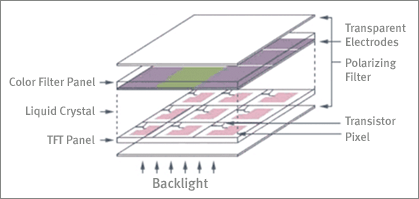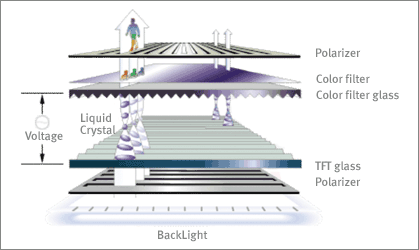Samsung 172B 17" LCD
Review by Navid Mortezaei on 03.07.03
Overview:
The SyncMasterTM 172B multimedia LCD produces sharp, crisp text and images with a high contrast ratio of 500:1 and high brightness of 250
cd/m2. A contrast ratio of 500:1 is one of the highest (best) available to the
consumer market, and compares with measly 200:1 of competitors. And with an ultra-thin 1.0" panel profile, the 172B has a lot more going for it than just
the Samsung name and basic LCD technology. With its integrated speakers, the 172B is ideal for any environment where space is
scarce.
| History of the TFT LCD | |||
| Liquid crystal was discovered by the Austrian botanist Fredreich Rheinizer in 1888. "Liquid crystal" is neither solid nor liquid (an example is soapy water). In the mid-1960's, scientists showed that liquid crystals, when stimulated by an external electrical charge, could change the properties of light passing through the crystals. The early prototypes (late 1960's) were too unstable for mass production. But all of that changed when a British researcher designed a stable, liquid crystal material (biphenyl). Today's color LCDs have a sandwich-like structure (see figure below). |
|||
 |
|||
| What is TFT LCD? | ||
| TFT LCD (Thin Film Transistor Liquid Crystal Display) has a sandwich-like structure with liquid crystal filled between two glass plates. | ||
 |
||
| TFT Glass has as many transistors (TFT's) as the number of pixels displayed, while Color Filter Glass has a color filter, which generates color. Liquid crystals move according to the difference in voltage between the Color Filter Glass and the TFT Glass. The amount of light supplied by the backlight is determined by the amount of movement of the liquid crystals in such a way as to generate color. |
| The most common liquid-crystal displays (LCD's) in use today rely on picture elements, or pixels, formed by liquid-crystal (LC) cells that change the polarization direction of light passing through them in response to an electrical voltage. As the polarization direction changes, more or less of the light is able to pass through a polarizing layer on the face of the display. Change the voltage, and the amount of light is changed. There are two ways to produce a liquid-crystal image with such cells: the segment driving method and the matrix driving method. The segment driving method displays characters and pictures with cells defined by patterned electrodes. The matrix driving method displays characters and pictures in sets of dots. |
|||
| 1. Direct vs. multiplex driving of LCDs. | |||
 |
|||
| The segment drive method is used for simple displays, such as those in calculators, while the dot-matrix drive method is used for high-resolution displays, such as those in portable computers and TFT monitors. Two types of drive method are used for matrix displays. In the static, or direct, drive method, each pixel is individually wired to a driver. This is a simple driving method, but, as the number of pixels is increased, the wiring becomes very complex. An alternative method is the multiplex drive method, in which the pixels are arranged and wired in a matrix format. To drive the pixels of a dot-matrix LCD, a voltage can be applied at the intersections of specific vertical signal electrodes and specific horizontal scanning electrodes. This method involves driving several pixels at the same time by time-division in a pulse drive. Therefore, it is also called a multiplex, or dynamic, drive method. |
|||
| « Previous Page | Next Page » |

